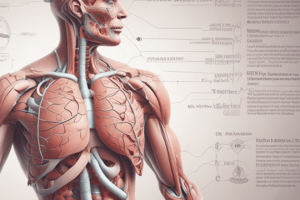Podcast
Questions and Answers
What is the primary function of the conduction portions of the human respiratory system?
What is the primary function of the conduction portions of the human respiratory system?
- To exchange oxygen and carbon dioxide
- To trap extraneous matter and remove carbon dioxide
- To provide a passageway for air and warm, moisten, and clean it (correct)
- To regulate breathing rate and depth
What structures are responsible for trapping particulate matter in the nasalcavity?
What structures are responsible for trapping particulate matter in the nasalcavity?
- Sebaceous glands and mucous glands
- Hair and sebaceous glands (correct)
- Mucous glands and serous glands
- Cilia and mucous glands
Which of the following is NOT a part of the respiratory portion of the human respiratory system?
Which of the following is NOT a part of the respiratory portion of the human respiratory system?
- Respiratory bronchioles
- Alveolar ducts
- Alveolar sacs
- Terminal bronchioles (correct)
What is the primary function of the respiratory portion of the human respiratory system?
What is the primary function of the respiratory portion of the human respiratory system?
Which of the following muscles is involved in the human respiratory system?
Which of the following muscles is involved in the human respiratory system?
Flashcards are hidden until you start studying
Study Notes
Human Respiratory System
- The human respiratory system consists of:
- Nose/nasal cavity
- Pharynx (nasopharynx, oropharynx)
- Larynx
- Trachea
- Bronchi
- Lungs (bronchial tree and alveoli)
- Skeletal muscles (diaphragm, intercostal muscle)
Conducting Portions
- Function to provide a passageway for air, warming, moistening, and cleaning it
- Consist of:
- Nasopharynx
- Larynx
- Trachea
- Bronchi
- Bronchioles
- Terminal bronchioles
- Clean, moisten, and warm the incoming air by:
- Hair and secretion of sebaceous glands in nasal cavity trapping particulate matter
- Secretions of mucous and serous glands in trachea and lower portion moistening the air and trapping extraneous matter
Respiratory Portions
- Serve to get rid of carbon dioxide and pick up oxygen
- Consist of:
- Respiratory bronchioles
- Alveolar ducts
- Alveolar sac
- Alveoli, the tiny air sacs, are the site of gas exchange
Studying That Suits You
Use AI to generate personalized quizzes and flashcards to suit your learning preferences.



